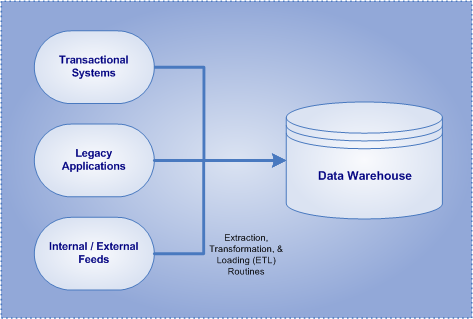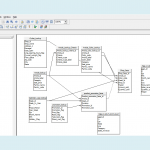
Data warehouses (DW) are centralized data repositories that integrate data from various transactional, legacy, or external systems, applications, and sources. The data warehouse provides an environment separate from the operational systems and is completely designed for decision-support, analytical-reporting, ad-hoc queries, and data mining. This isolation and optimization enables queries to be performed without any impact on the systems that support the business’ primary transactions (i.e transactional and operational systems).

- Fundamentally, a data warehouse helps solve the on-going problem of pulling data out of transactional systems quickly and efficiently and converting that data into actionable information. Additionally, the data warehouse allows for processing of large and complex queries in a highly-efficient manner. Upon successful implementation of a data warehouse or data mart, business will realize numerous improvements and positive gains.
- Benefits from a successful implementation of a data warehouse include:
- • Enhanced Business Intelligence
- • Increased Query and System Performance
- • Business Intelligence from Multiple Sources
- • Timely Access to Data
- • Enhanced Data Quality and Consistency
- • Historical Intelligence
- • High Return on Investment
Benefit of a DW: Enhanced Business Intelligence
Insights will be gained through improved information access. Managers and executives will be freed from making their decisions based on limited data and their own “gut feelings”. Decisions that affect the strategy and operations of organizations will be based upon credible facts and will be backed up with evidence and actual organizational data. Moreover, decision makers will be better informed as they will be able to query actual data will retrieve information based upon their personal needs. In addition, data warehouses and related business intelligence can be used to can be applied directly to business processes including marketing segmentation, inventory management, financial management, and sales.
Benefit of a DW: Increased System and Query Performance
Data warehouses are purposely designed and constructed with a focus on speed of data retrieval and analysis. Moreover, a data warehouse is designed for storing large volumes of data and being able to rapidly query the data. These analtical systems are constructed differently from operational systems which focus on creation and modification of data. In contrast, the data warehouse is built for analysis and retrieval of data rather than efficient upkeep of invidual records (i.e. transactions). Further, the data warehouse allows for a large system burden to be taken off the operational environment and effectively distributes system load across an entire organization’s technology infrastructure.
Benefit of a DW: Business Intelligence from Multiple Sources
For many organizations, enterprise information systems are comprised of multiple subsystems, physically separated and built on different platforms. Moreover, merging data from multiple disparate data sources is a common need when conducting business intelligence. To solve this problem, the data warehouse performs integration of existing disparate data sources and makes them accessible in one place. Consolidating enterprise data into a single data repository alleviates the burden of duplicating data gathering efforts, and enables the extraction of information that would otherwise be impossible. Additionally, the data warehouse becomes the “single view of truth” for the enterprise rather than the multiple truths that can come from reporting on individual subsystems.
Benefit of a DW: Timely Access to Data
The data warehouse enables business users and decision makers to have access to data from many different sources as they need to have access to the data. Additionally, business users will spend little time in the data retrieval process. Scheduled data integration routines, known as ETL, are leveraged within a data warehouse environment. These routines consolidate data from multiple source systems and transform the data into a useful format. Subsequently, business users can then easily access data from one interface. Further, consumers of data will be able to query data directly with less information technology support. The wait time for information technology professionals to develop reports and queries is greatly diminished as the business users are given the ability to generate reports and queries on their own. The use of query and analysis tools against a consistent and consolidated data repository enables business users to spend more time performing data analysis and less time gathering data.
Benefit of a DW: Enhanced Data Quality and Consistency
A data warehouse implementation typically includes the conversion of data from numerous source systems and data files and transformation of the disparate data into a common format. Data from the various business units and departments is standardized and the inconsistent nature of data from the unique source systems is removed. Moreover, individual business units and departments including sales, marketing, finance, and operations, will start to utilize the same data repository as the source system for their individual queries and reports. Thus each of these individual business units and departments will produce results that are consistent with the other business units within the organization. Subsequently the overall confidence in the organization’s data is substantially increased.
Benefit of a DW: Historical Intelligence
Data warehouses generally contain many years worth of data that can neither be stored within nor reported from a transactional system. Typically transactional systems satisfy most operating reporting requirements for a given time-period but without the inclusion of historical data. In contrast, the data warehouse stores large amounts of historical data and can enable advanced business intelligence including time-period analysis, trend analysis, and trend prediction. The advantage of the data warehouse is that it allows for advanced reporting and analysis of multiple time-periods.
Benefit of a DW: High Return on Investment (ROI):
Return on investment (ROI) refers to the amount of increased revenue or decreased expenses a business will be able to realize from any project or investment of capital. Subsequently, implementations of data warehouses and complementary business intelligence systems have enabled business to generate higher amounts of revenue and provide substantial cost savings. According to a 2002 International Data Corporation (IDC) study “The Financial Impact of Business Analytics”, analytics projects have been achieving a substantial impact on a business’ financial status. Additionally, the study found that business analytics implementations have generated a median five-year return on investment of 112% with a mean payback of 1.6 years. Of the businesses included in the study, 54% have had a return on investment of 101% or more.



